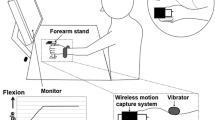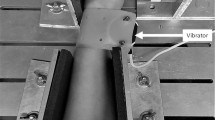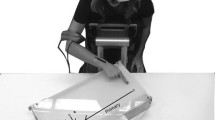Abstract
Tendon vibration is used extensively to assess the role of peripheral mechanoreceptors in motor control, specifically, the muscle spindles. Periodic tendon vibration is known to activate muscle spindles and induce a kinesthetic illusion that the vibrated muscle is longer than it actually is. Noisy tendon vibration has been used to assess the frequency characteristics of proprioceptive reflex pathways during standing; however, it is unknown if it induces the same kinesthetic illusions as periodic vibration. The purpose of the current study was to assess the effects of both periodic and noisy tendon vibration in a kinesthetic targeting task. Participants (N = 15) made wrist extension movements to a series of visual targets without vision of the limb, while their wrist flexors were either vibrated with periodic vibration (20, 40, 60, 80, and 100 Hz), or with noisy vibration which consisted of filtered white noise with power between ~ 20 and 100 Hz. Overall, our results indicate that both periodic and noisy vibration can induce robust targeting errors during a wrist targeting task. Specifically, the vibration resulted in an undershooting error when moving to the target. The findings from this study have important implications for the use of noisy tendon vibration to assess proprioceptive reflex pathways and should be considered when designing future studies using noisy vibration.



Similar content being viewed by others
Data availability
The datasets generated during and/or analyzed during the current study are available from the corresponding author on reasonable request.
References
Arcangel CS, Johnston R, Bishop B (1971) The Achilles tendon reflex and the H-response during and after tendon vibration. Phys Ther 51:889–905. https://doi.org/10.1093/ptj/51.8.889
Burke D, Hagbarth KE, Löfstedt L, Wallin BG (1976a) The responses of human muscle spindle endings to vibration of non-contracting muscles. J Physiology 261:673–693. https://doi.org/10.1113/jphysiol.1976.sp011580
Burke D, Hagbarth KE, Löfstedt L, Wallin BG (1976b) The responses of human muscle spindle endings to vibration during isometric contraction. J Physiology 261:695–711. https://doi.org/10.1113/jphysiol.1976.sp011581
Cordo P, Gurfinkel VS, Bevan L, Kerr GK (1995) Proprioceptive consequences of tendon vibration during movement. J Neurophysiol 74:1675–1688. https://doi.org/10.1152/jn.1995.74.4.1675
Eklund G, Hagbarth KE (1966) Normal variability of tonic vibration reflexes in man. Exp Neurol 16:80–92. https://doi.org/10.1016/0014-4886(66)90088-4
Ernst MO, Banks MS (2002) Humans integrate visual and haptic information in a statistically optimal fashion. Nature 415:429–433. https://doi.org/10.1038/415429a
Eschelmuller G, Mildren RL, Blouin J-S et al (2020) Frequency characteristics of heteronymous responses evoked by Achilles tendon vibration during quiet stance. Neurosci Lett 736:135290. https://doi.org/10.1016/j.neulet.2020.135290
Eschelmuller G, Chua R, Carpenter MG, Inglis JT (2021) The acute effects of periodic and noisy tendon vibration on wrist muscle stretch responses. Neurosci Lett 764:136279. https://doi.org/10.1016/j.neulet.2021.136279
Fallon JB, Macefield VG (2007) Vibration sensitivity of human muscle spindles and Golgi tendon organs. Muscle Nerve 36:21–29. https://doi.org/10.1002/mus.20796
Gail PD, Lance JW, Neilson PD (1966) Differential effects on tonic and phasic reflex mechanisms produced by vibration of muscles in man. J Neurol Neurosurg Psychiatry 29:1–11. https://doi.org/10.1136/jnnp.29.1.1
Gillies JD, Lance JW, Neilson PD, Tassinari CA (1969) Presynaptic inhibition of the monosynaptic reflex by vibration. J Physiology 205:329–339. https://doi.org/10.1113/jphysiol.1969.sp008968
Gillies JD, Burke DJ, Lance JW (1971) Supraspinal control of tonic vibration reflex. J Neurophysiol 34:302–309. https://doi.org/10.1152/jn.1971.34.2.302
Goodwin GM, McCloskey DI, Matthews PBC (1972) Proprioceptive illusions induced by muscle vibration: contribution by muscle spindles to perception? Science 175:1382–1384. https://doi.org/10.1126/science.175.4028.1382
Hagura N, Takei T, Hirose S et al (2007) Activity in the posterior parietal cortex mediates visual dominance over kinesthesia. J Neurosci 27:7047–7053. https://doi.org/10.1523/jneurosci.0970-07.2007
Hayashi R, Miyake A, Jijiwa H, Watanabe S (1981) Postural readjustment to body sway induced by vibration in man. Exp Brain Res 43:217–225. https://doi.org/10.1007/bf00237767
Hodgson DD, King JA, Darici O et al (2023) Visual feedback-dependent modulation of arousal, postural control, and muscle stretch reflexes assessed in real and virtual environments. Front Hum Neurosci 17:1128548. https://doi.org/10.3389/fnhum.2023.1128548
Inglis JT, Frank JS (1990) The effect of agonist/antagonist muscle vibration on human position sense. Exp Brain Res 81:573–580. https://doi.org/10.1007/bf02423506
Inglis JT, Frank JS, Inglis B (1991) The effect of muscle vibration on human position sense during movements controlled by lengthening muscle contraction. Exp Brain Res 84:631–634. https://doi.org/10.1007/bf00230975
Izumizaki M, Tsuge M, Akai L et al (2010) The illusion of changed position and movement from vibrating one arm is altered by vision or movement of the other arm. J Physiol 588:2789–2800. https://doi.org/10.1113/jphysiol.2010.192336
Kabbaligere R, Lee B-C, Layne CS (2017) Balancing sensory inputs: Sensory reweighting of ankle proprioception and vision during a bipedal posture task. Gait Posture 52:244–250. https://doi.org/10.1016/j.gaitpost.2016.12.009
Kadri MA, Chevalier G, Mecheri H et al (2020) Time course and variability of tendinous vibration-induced postural reactions in forward and backward directions. J Electromyogr Kinesiol 51:102386. https://doi.org/10.1016/j.jelekin.2020.102386
Kadri MA, Bouchard E, Lauzier L et al (2023) Distinctive phases and variability of vibration-induced postural reactions highlighted by center of pressure analysis. PLoS ONE 18:e0280835. https://doi.org/10.1371/journal.pone.0280835
Lackner JR, Taublieb AB (1984) Influence of vision on vibration-induced illusions of limb movement. Exp Neurol 85:97–106. https://doi.org/10.1016/0014-4886(84)90164-x
Maurer C, Mergner T, Peterka RJ (2005) Multisensory control of human upright stance. Exp Brain Res 171:231. https://doi.org/10.1007/s00221-005-0256-y
McCloskey DI (1973) Differences between the senses of movement and position shown by the effects of loading and vibration of muscles in man. Brain Res 61:119–131. https://doi.org/10.1016/0006-8993(73)90521-0
Mildren RL, Peters RM, Hill AJ et al (2017) Frequency characteristics of human muscle and cortical responses evoked by noisy Achilles tendon vibration. J Appl Physiol 122:1134–1144. https://doi.org/10.1152/japplphysiol.00908.2016
Mildren RL, Peters RM, Carpenter MG et al (2019) Soleus single motor units show stronger coherence with Achilles tendon vibration across a broad bandwidth relative to medial gastrocnemius units while standing. J Neurophysiol 122:2119–2129. https://doi.org/10.1152/jn.00352.2019
Mildren RL, Schmidt ME, Eschelmuller G et al (2020) Influence of age on the frequency characteristics of the soleus muscle response to Achilles tendon vibration during standing. J Physiology 598:5231–5243. https://doi.org/10.1113/jp280324
Mildren RL, Peters RM, Carpenter MG et al (2021) Soleus responses to Achilles tendon stimuli are suppressed by heel and enhanced by metatarsal cutaneous stimuli during standing. J Physiol 599:3611–3625. https://doi.org/10.1113/jp281744
Peterka RJ (2002) Sensorimotor integration in human postural control. J Neurophysiol 88:1097–1118. https://doi.org/10.1152/jn.2002.88.3.1097
Proske U, Gandevia SC (2012) The proprioceptive senses: their roles in signaling body shape, body position and movement, and muscle force. Physiol Rev 92:1651–1697. https://doi.org/10.1152/physrev.00048.2011
Proske U, Gandevia SC (2018) Kinesthetic senses. Compr Physiol 8:1157–1183. https://doi.org/10.1002/cphy.c170036
Roll JP, Vedel JP (1982) Kinaesthetic role of muscle afferents in man, studied by tendon vibration and microneurography. Exp Brain Res 47:177–190. https://doi.org/10.1007/bf00239377
Roll JP, Vedel JP, Ribot E (1989) Alteration of proprioceptive messages induced by tendon vibration in man: a microneurographic study. Exp Brain Res 76:213–222. https://doi.org/10.1007/bf00253639
Seizova-Cajic T, Azzi R (2011) Conflict with vision diminishes proprioceptive adaptation to muscle vibration. Exp Brain Res 211:169–175. https://doi.org/10.1007/s00221-011-2663-6
Sittig AC, van der Gon JJD, Gielen CCAM (1985) Separate control of arm position and velocity demonstrated by vibration of muscle tendon in man. Exp Brain Res 60:445–453. https://doi.org/10.1007/bf00236930
Sittig AC, van der Gon Denier JJ, Gielen CCAM (1987) The contribution of afferent information on position and velocity to the control of slow and fast human forearm movements. Exp Brain Res 67:33–40. https://doi.org/10.1007/bf00269450
Tsuge M, Izumizaki M, Kigawa K et al (2012) Interaction between vibration-evoked proprioceptive illusions and mirror-evoked visual illusions in an arm-matching task. Exp Brain Res 223:541–551. https://doi.org/10.1007/s00221-012-3281-7
van Beers RJ, Sittig AC, van der Gon JJD (1999) Integration of proprioceptive and visual position-information: an experimentally supported model. J Neurophysiol 81:1355–1364. https://doi.org/10.1152/jn.1999.81.3.1355
Acknowledgements
Not applicable.
Funding
This work was supported by the Natural Sciences and Engineering Research Council to JTI [Grant number: 2017-04504] and RC [Grant number: 2019-04513] and a graduate research award to GE.
Author information
Authors and Affiliations
Contributions
GE: conceptualization, methodology, formal analysis, investigation, visualization, and writing—original draft. AS: investigation, writing—review and editing. BG: investigation, writing—review and editing. RC: conceptualization, methodology, writing—review and editing, supervision, and funding acquisition. JTI: conceptualization, methodology, writing—review and editing, supervision, and funding acquisition.
Corresponding author
Ethics declarations
Conflict of interest
The authors declare that they have no conflict of interest.
Ethical approval and consent to participate
All procedures used in this study were approved by the behaviour research ethics board at the University of British Columbia. Freely given informed written consent was obtained from all participants prior to participation in any study procedures.
Consent for publication
All participants consented for their de-identified data to be published.
Additional information
Communicated by Bill J Yates.
Publisher's Note
Springer Nature remains neutral with regard to jurisdictional claims in published maps and institutional affiliations.
Rights and permissions
Springer Nature or its licensor (e.g. a society or other partner) holds exclusive rights to this article under a publishing agreement with the author(s) or other rightsholder(s); author self-archiving of the accepted manuscript version of this article is solely governed by the terms of such publishing agreement and applicable law.
About this article
Cite this article
Eschelmuller, G., Szarka, A., Gandossi, B. et al. The effects of periodic and noisy tendon vibration on a kinesthetic targeting task. Exp Brain Res 242, 59–66 (2024). https://doi.org/10.1007/s00221-023-06727-1
Received:
Accepted:
Published:
Issue Date:
DOI: https://doi.org/10.1007/s00221-023-06727-1




